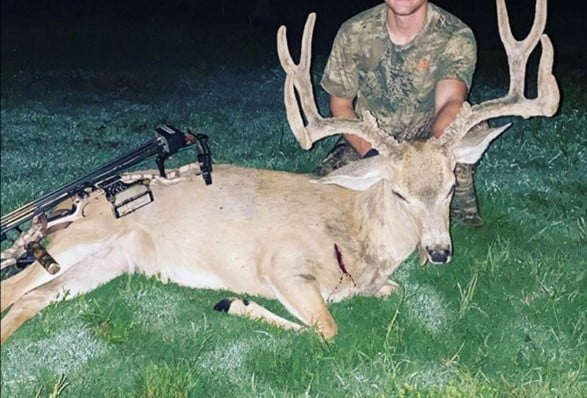Take a trip to a Michigan Turkey Tract

By BOB GWIZDZ
Michigan Department of Natural Resources
Perhaps many Michiganders have never heard of a Turkey Tract, but they’re gaining in popularity as the Michigan  Department of Natural Resources opened its third such site this spring at the Barry State Game Area, near Middleville, in Barry County.
Department of Natural Resources opened its third such site this spring at the Barry State Game Area, near Middleville, in Barry County.
Turkey Tracts are demonstration areas, complete with trails, designed to show newcomers to turkey hunting – or other wild turkey aficionados – exactly what prime turkey habitat looks like.
The tracts are similar to the DNR’s Grouse Enhanced Management Sites (GEMS), which highlight ruffed grouse and American woodcock habitat. However, the two programs differ in significant ways, including where you can find them in Michigan.
GEMS are located within the northern Lower Peninsula and the Upper Peninsula, where most of the better grouse and woodcock habitat can be found. In addition, GEMS are heavily managed to maintain early-succession, high-stem density forest, where grouse and woodcock thrive.
Wild turkeys have less specific habitat needs. As adults they thrive in mature woodlots, but they need grasslands for nesting and brood-rearing. Good deer habitat is typically good turkey habitat.
So the land management at Turkey Tracts is less specific than at GEMS and includes maintaining openings and establishing food plots.
 The additional existing turkey tracts at the Allegan State Game Area in Allegan County and the Flat River State Game Area in Montcalm County are located near established foot-traffic paths in places that are often the remnants of old logging trails. The trails are often planted with clover or some other vegetation that wild turkeys will use.
The additional existing turkey tracts at the Allegan State Game Area in Allegan County and the Flat River State Game Area in Montcalm County are located near established foot-traffic paths in places that are often the remnants of old logging trails. The trails are often planted with clover or some other vegetation that wild turkeys will use.
All three Turkey Tracts are situated generally in the southwestern part of the state.
“Southern Michigan has always been prime turkey habitat,” said Al Stewart, the DNR’s upland game bird specialist. “A lot of the release sites during our turkey restoration activities were on southern Michigan state game areas.”
The Turkey Tracts program is the result of a partnership between the Michigan chapter of the National Wild Turkey Federation and the DNR.
“The Turkey Federation is doing the heavy lifting,” Stewart said. “They’re paying for the signage materials and placing the signs. The kiosks are being made by federation members.”
The Michigan chapter of the Federation has gone all-in on Turkey Tracts.
“It’s a wonderful cooperative effort between the DNR and the NWTF,” said Art Pelon, president of the Michigan National Wild Turkey Federation chapter. “It provides access to the woods for youths and handicapped hunters by providing foot trails that make it easier for hunters to get in and out of good habitat.
“It’s a fantastic opportunity to give people who are not experienced in turkey hunting a good launching point. It’s a  great way to go out and get into the outdoors.”
great way to go out and get into the outdoors.”
Ryan Boyer, a regional biologist with the federation, said an important aspect of the Turkey Tracts program is the connection it makes between hunters, state game areas and local communities.
Businesses in the game area’s vicinity help sponsor information kiosks at the sites, and hunters who take a selfie photograph at the kiosks and show it at participating businesses are eligible for discounts.
“It makes a connection between local businesses and hunters and helps illustrate the economic impact of hunting … something that I think is often overlooked,” Boyer said. “A lot of people are completely unaware how these resources are funded – by hunters.”
The kiosks are being made by federation members and students at Belding schools.
Boyer said that habitat management benefits not only turkeys but other game and nongame species that use these areas.
“It’s a beneficial program that we’re excited we can help build on and expand,” Boyer said.
Expansion is in the works, Stewart said, and eventually there will be a series of Turkey Tracts across southern Michigan, not unlike the way GEMS are sprinkled around the northern portions of the state.
“The next ones are envisioned for southeastern Michigan,” Stewart said, “at game areas – places like Lapeer, Holly, Waterloo or Tuscola.”
The partnership is expanding as well, Stewart said.
“If you’ve never hunted turkeys before, get on the trail at a Turkey Tract before sunrise and call and maybe locate a turkey gobbling and sit down and hunt him,” Stewart said. “And these sites are great places for hunters with mobility issues, as they’re not climbing over logs or stumbling over other obstructions out there in the dark when they get on the trail.”
Over the past several decades, rehabilitation of wild turkey populations in Michigan has been a dramatic success.
Wild turkeys were totally wiped out in Michigan in the late 1800s, but their populations have been rebuilt to where they can be found in all 68 counties of the Lower Peninsula and in most of the Upper Peninsula’s 15 counties. Only seven states harvest more wild turkeys than Michigan.
Get more information on the DNR’s Turkey Tracts at michigan.gov/turkey.
